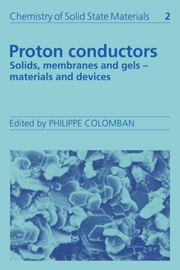Book contents
- Frontmatter
- Contents
- List of contributors
- Preface
- Symbols
- I HYDROGEN BOND AND PROTONIC SPECIES
- II MATERIALS: PREPARATION, STRUCTURES AND PROPERTIES
- 7 Structure and characterization of hydrogen insertion compounds of metal oxides
- 8 High temperature proton conductors based on perovskite-type oxides
- 9 Highly ionic hydroxides: unexpected proton conductivity in Mg(OH)2 and homologues
- 10 Ice
- 11 Anhydrous materials: oxonium perchlorate, acid phosphates, arsenates, sulphates and selenates
- 12 Hydrogen behaviour in graphite–nitric acid intercalation compounds
- 13 Proton-containing β- and β″-alumina structure type compounds
- 14 Proton conduction in zeolites
- 15 Proton containing NASICON phases
- 16 Phosphates and phosphonates of tetravalent metals as protonic conductors
- 17 Hydrogen uranyl phosphate, H3OUO4PO4. 3H2O (HUP), and related materials
- 18 From crystalline to amorphous (particle) hydrates: inorganic polymers, glasses, clays, gels and porous media
- 19 Perfluorinated membranes
- 20 Mixed inorganic-organic systems: the acid/polymer blends
- III PROTON DYNAMICS AND CHARGE TRANSPORT
- IV PROTON DIFFUSION MECHANISMS
- V DEVICES
- Index
15 - Proton containing NASICON phases
Published online by Cambridge University Press: 04 May 2010
- Frontmatter
- Contents
- List of contributors
- Preface
- Symbols
- I HYDROGEN BOND AND PROTONIC SPECIES
- II MATERIALS: PREPARATION, STRUCTURES AND PROPERTIES
- 7 Structure and characterization of hydrogen insertion compounds of metal oxides
- 8 High temperature proton conductors based on perovskite-type oxides
- 9 Highly ionic hydroxides: unexpected proton conductivity in Mg(OH)2 and homologues
- 10 Ice
- 11 Anhydrous materials: oxonium perchlorate, acid phosphates, arsenates, sulphates and selenates
- 12 Hydrogen behaviour in graphite–nitric acid intercalation compounds
- 13 Proton-containing β- and β″-alumina structure type compounds
- 14 Proton conduction in zeolites
- 15 Proton containing NASICON phases
- 16 Phosphates and phosphonates of tetravalent metals as protonic conductors
- 17 Hydrogen uranyl phosphate, H3OUO4PO4. 3H2O (HUP), and related materials
- 18 From crystalline to amorphous (particle) hydrates: inorganic polymers, glasses, clays, gels and porous media
- 19 Perfluorinated membranes
- 20 Mixed inorganic-organic systems: the acid/polymer blends
- III PROTON DYNAMICS AND CHARGE TRANSPORT
- IV PROTON DIFFUSION MECHANISMS
- V DEVICES
- Index
Summary
Triphosphate phases
Tetravalent metals readily form triphosphates of the type M(I)M(IV)2(PO4)3, where M(I) may be any alkali metal and M(IV) is most commonly Zr. A large number of such compounds have been synthesized by high temperature solid state methods. These compounds are of interest because they are low expansion materials and form the basis for an extensive family of solid electrolytes. Single crystals of NaZr2(PO4)3 have been grown from melts and the structure determined. A schematic drawing of a portion of the structure is shown in Fig. 15.1. The crystals are rhombohedral a = 8.8043(2) Å, c = 22.7585(9) Å, space group. The structure consists of zirconium octahedra and phosphate tetrahedra which are linked by corners. A basic unit consists of two octahedra and three tetrahedra separated by Na+ ions which form columns parallel to the c axis. Thus, the structure consists of [Zr2(PO4)3]– anions and Na+ cations. The anions are linked together through bridging phosphate groups to form a rigid framework which creates cavities. The cavity labelled A in Fig. 15.1 contains the Na+ which is coordinated by phosphate oxygens in a trigonal anti-prism. Only half the structure in the a-direction is shown in the figure. On adding the second half, three more cavities are created. Six such cavities, three above and three below, termed type II, surround the A type (type I) and are connected through narrow passageways.
- Type
- Chapter
- Information
- Proton ConductorsSolids, Membranes and Gels - Materials and Devices, pp. 224 - 237Publisher: Cambridge University PressPrint publication year: 1992
- 2
- Cited by



